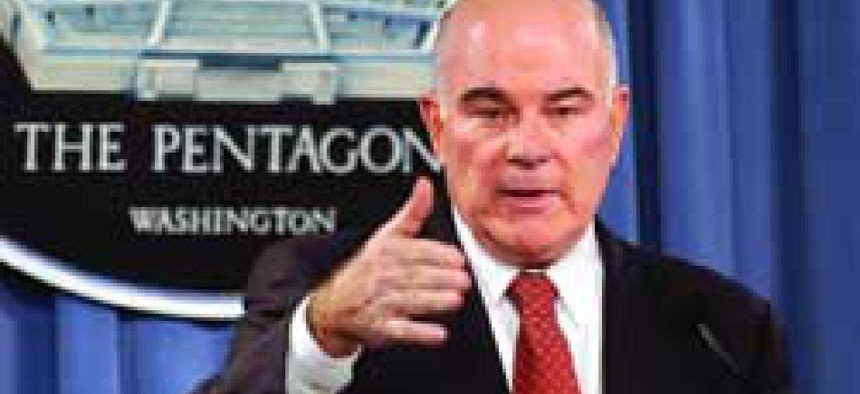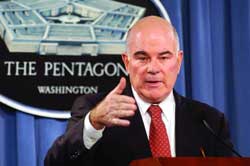Net-Centric changes on the horizon?


Connecting state and local government leaders
New leadership, troop build-up could hinder modernization programs.

We need to find the resources to build the force [but] it can't be done at the expense of transformation and modernization.' Francis Harvey, secretary of the Army
R.D. Ward
One of the most significant changes came Jan. 11, when new Defense secretary Robert Gates recommended increasing the size of Army and Marine Corps ground forces by 92,000 over five years, scrapping predecessor Donald Rumsfeld's notions of a light, lean military.
'I am confident that the increase in troop end strength will be supported on both sides of the aisle,' secretary of the Army Francis Harvey said during a recent appearance at the Heritage Foundation in Washington.
Rep. Ike Skelton (D-Mo.), chairman of the House Armed Services Committee, echoed that belief. 'I have long advocated for an increase in Army and Marine Corps end strength,' he said in a statement.
But adding tens of thousands of new troops also will cost money'as much as $100 billion through 2013'which could affect the Pentagon's planned modernization programs. 'We need to find the resources to build the force,' Harvey said, but 'it can't be done at the expense of transformation and modernization.'
The QDR had advocated increasing investments in unmanned aerial vehicles and adding resources to implement the Global Information Grid, the Transformational Satellite program and the Global Force Management System, among others.
These programs are fundamental to recasting the military for network-centric warfare, an arena where the United States holds a potentially prohibitive advantage over other nations. But the programs are expensive. Building the GIG out to its full potential could cost hundreds of billions of dollars over the next 20 years. TSAT's price tag is $16 billion, and the first satellite is not expected to launch until 2014.
Another key program, the Army's Future Combat Systems, is projected to cost $21 billion for R&D alone between this year and 2016, according to the Congressional Budget Office.
Some experts believe Congress will boost DOD's budget in the short term to meet these needs. 'Congress may let the Defense budget grow by leaps and bounds this year,' said Lawrence Korb, an assistant Defense secretary in the Reagan administration and now a senior fellow at the Center for American Progress.
In the long run, however, tighter management over ballooning technology costs will be required, according to Ronald Jost, deputy assistant secretary of Defense for command, control, communications, space and spectrum. 'As the secretary and the president determine the direction, we will tailor and balance the IT budget with all the other budgets.' This will increasingly be accomplished by managing integrated portfolios of capabilities, he said.
Some cracks in modernization spending can already be seen, however.
Harvey said the Army's fiscal 2008 budget request will cut UAV platforms from four to two, and Future Combat Systems platforms from 18 to 14.
The biggest impact on modernization, Korb said, could come in the later years of any troop buildup, as expenses to maintain the larger force become cumulative.
Another expert sees the possibility that the services will forgo personnel increases in favor of investing in modernization.
'The end strength increase will not be completed until 2012,' said Steven Kosiak, director of budget studies for the Center for Strategic and Budgetary Assessments. 'A lot can change in the intervening years, especially if we get out of Iraq. The services may feel greater pressure to protect modernization programs than to continue adding troops.'
For James Carafano, senior research fellow at the Heritage Foundation, the moment of truth will come in two or three years, if U.S. involvement in Iraq winds down. At that point, tension will likely emerge between Defense spending and growing social entitlements. Unless the government addresses spending on Social Security and Medicare, he said, advanced military technologies may be one of the victims of a future budget crunch.
As emerging technologies undergo phases of spiral development, the Defense budget doesn't feel too much of a pinch, Carafano said. But, he asked, 'when the time comes for procurement, will the money be there?'
NEXT STORY: The evolving role of the CIO




